It’s been almost two weeks since we last looked at the Traffic Antifa series. In that last piece we looked at some guy who was soying out over the buses in Oklahoma City, and whining that there weren’t more of them, despite the one he got on being completely empty. I thought I’d write another quick piece, looking at a few real world examples to dispel the “a bus represents 150 cars not on the road,” myth that you’ll see snarkily “shown” with images such as the one below.
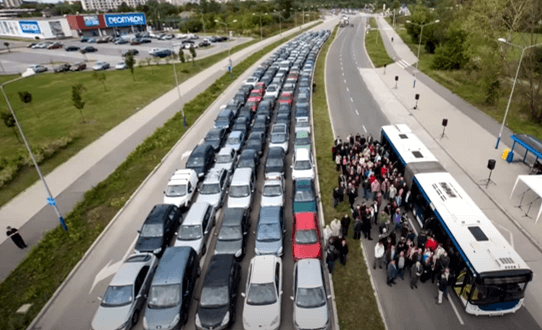
How many people are actually in the average bus?
Many taxpayers get irate when they see huge buses taking up road space with almost no passengers on board. Transit agencies tint or screen bus windows either to reduce air conditioning costs or to allow billboard-type advertising, but to an outside observer it looks like they are trying to cover up the fact that so many seats are empty.
According to the 2013 National Transit Database, the average urban transit bus (including commuter buses and rapid transit buses) has 39 seats but carries an average of just 11.1 people (calculated by dividing passenger miles by vehicle-revenue miles). That’s actually an improvement from 2012, when the average load was 10.7 people. But it’s a big drop from 1979, when the average loads appear to have exceeded 15 people.*
This is even worse than you think, since they’re comparing passenger-miles to vehicle revenue-miles. This doesn’t factor in the buses running while not in service. Also, the seating capacity and the total capacity are two very different things on urban transit buses, due to standing capacity.
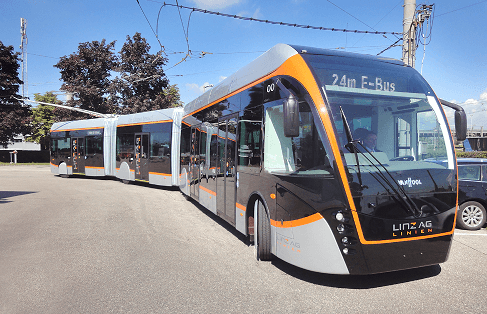
The standing capacity is typically around an additional 75% of the number of seats. We can take those roughly 40 seats, and assume buses with an average capacity of 70. They have a whopping 11.1 people in them on average. That’s less than 16% of their max capacity being used on average.
Again, this piece is from 2015. If the graph continued until today we’d see it nosedive, as (((BLM))) terrorized cities across North America see nearly half their ridership refuse to come back. That’s why transit is being cut back wherever possible. No one wants to die when getting to work.
Low bus loads explain why buses use about as much energy per passenger mile as the average SUV. But buses don’t have to be empty. Buses that transit agencies classified as commuter buses, which operate mainly during rush hours, carried an average of 19.6 passengers in 2013. Some are much higher: commuter buses in Sherman, TX; Hyannis, MA; Everett, WA; Baltimore; Hoboken; and Lompoc, CA all manage to fill more than 30 seats on average. Most of these lines use motorcoach-type buses, with around 55 cushy seats but little standing room. Some of Everett’s buses are double-decker buses.

By motorcoach bus he means this style. I’ve ridden on this type as part of my daily commute quite a bit. I’m not sure if he isn’t totally mixing up cause and effect though, as this style is typically used for inter-city transportation, where the bus is going on the highway for a large portion of its trip straight to another bus station, with no stops in between. Those kinds of trips probably do have higher usage, since they avoid some of the spacing problems inherent to buses, congregate people at the start and end points, and are vastly superior to bicycles due to highway usage.
But transit agencies don’t have to cut service to rush hours to increase bus loads. Some operators of regular buses (listed as “MB” in the National Transit Data Base) have much higher-than-average loads. Honolulu buses carried an average of 20.9 people in 2013. Los Angeles County Metropolitan Transit Authority carried an average of 20.4 people.
One reason these transit agencies do well is they serve high-density cities with urban-growth boundaries, which means they don’t send a lot of buses to low-density suburbs. In 2010, urbanized Oahu had nearly 4,800 people per square mile, while urbanized Los Angeles County was nearly 6,900 people per square mile.

Once again, you need to have high population density, as well as a geographical area too big to walk, to make public transit viable. If you spend a ton of money on busing you don’t magically “induce demand,” for riding the bus. You just spend a lot of money on empty buses.
Population density isn’t enough, however; you also need some concentrated job centers. Nearly 92 percent of Pinellas County, Florida is urbanized with more than 3,600 people per square mile, yet Pinellas buses carried an average of less than 8 people in 2013. Pinellas commuter buses are even worse, carrying an average of just 5 people on buses with an average of 49 seats.
Back in 1991, Pinellas buses carried an average of 10.1 people. Over the next decade, PSTA increased bus service by 42 percent only to see a 29 percent decline in ridership, with the result that buses in 2001 carried an average of just 5.5 riders. Since then, occupancies have grown partly due to a 6 percent cut in service forced by the recession after the 2007 financial crisis.
B-b-but muh induced demand. Muh Katy Freeway. Muh heckin cuckboxerinos. They increased capacity so they should have seen increased demand, not decreased demand.

It’s incredibly satisfying to see real world data like this, considering that a mainstay of the arguments for wasting everyone’s taxdollars on busing or passenger rail is the “if you build it, they will come,” nonsense. Once again, demand for transportation is not infinite.
Complaints about empty buses led the Pinellas Suncoast Transit Authority to put out the [below] video claiming that buses may be empty at their extremities but are fuller near city centers. This doesn’t explain why the average Los Angeles bus carries more than 2-1/2 times as many people as the average Pinellas bus. Even at their fullest, the videos show empty seats and few standees.
That video is so ridiculous that I feel the need to transcribe part of it.
(Starting at 3:50)
So next time you see a bus that’s empty, please don’t assume that no one rides. Far from it. In fact, for Pernell Counties population, PSTA is a very undersized transit agency. Yet in 2012 we provided more than 14 million rides. That’s pretty impressive when you consider that we only run about 150 buses during weekday rush hour.
Why would you mention the total number of rides over the course of the year in the same sentence as the number of buses used during weekday rush hour? Why don’t you instead mention the total number of rides given during weekday rush hour instead?

Oh right, because that would make them look bad. If there’s any constant with these bureaucracies it’s that they will use any argument, no matter how spurious, to justify expanding the road clogging bus fleet.

Having said that, there is one good argument that they make that I feel the need to repeat, since it’s not really a good argument. They start off with the totally empty bus pictured above. It continues this way for over a mile and a half until passing its first major pickup zone.
(Starting at 1:40)
Here’s the load leaving Clearwater Mall. And as it continues along *inaudible* Boulevard into PSTA’s Park Street terminal in downtown Clearwater. Definitely not empty.
Only an urbanite could look at a half empty bus and consider it a win because it is not completely empty.
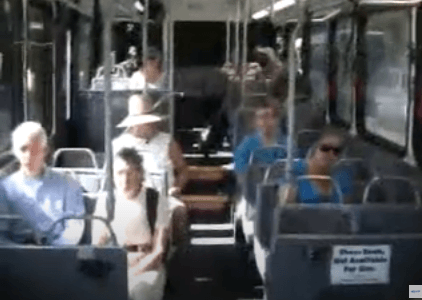
Additionally, as we saw with Ergyo Urbanism, buses do indeed run completely empty. His example was in Oklahoma, but the same goes for everywhere else they shove unnecessary buses.
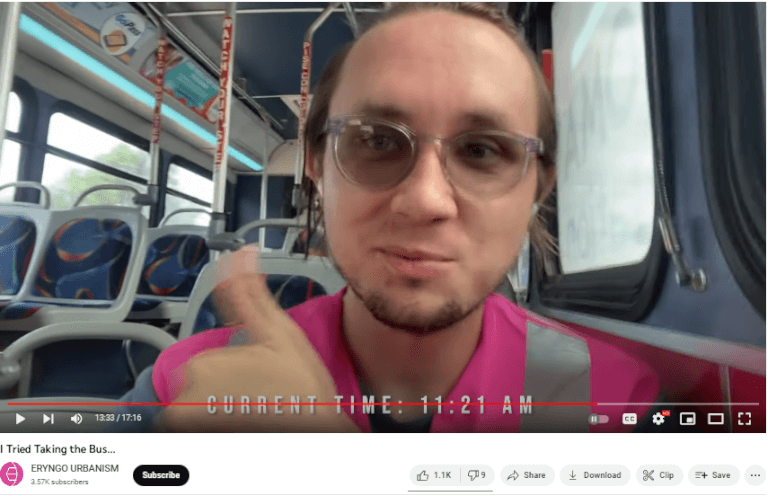
And keep in mind, they waived the fees on his bus. It was free and still empty.
Now let’s take a look at another route. The bus was nearly empty when it started, but look now as it approaches the halfway point of its run. Standing room only.
Here we had a bus that started out near empty, and is now too crowded for anyone else to get on, which also makes it very unpleasant for the riders. I love how these people start off by literally saying that one bus represents x cars off the road, and then fall back to “well they’re only empty some of the time.”
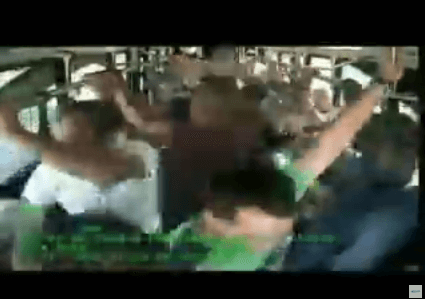
I didn’t do a perfect job explaining the Spacing Problem in my previous piece. That was the term that I gave for a problem unique to public transit, where they need to stop regularly, but not too regularly, to let people on and off the subway/bus. This slows down the trip for everyone.
But it also means that there’s a chance you won’t be able to get on the bus because it’s full, an experience that has happened to me a few times, making me late. That’s why it’s often best to be near the start of the line, even though you have to go further, because you are much less likely to have to watch multiple buses go by since they are already full.
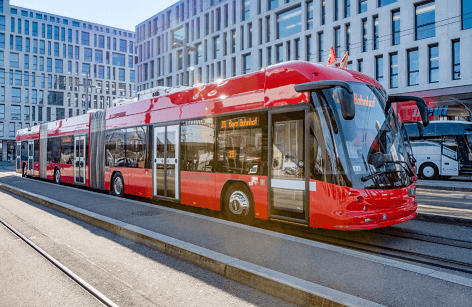
On the other hand, it means that the big huge chonker buses are running at very low capacity at the start of their trip, only increasing as they near the end of their line, assuming they actually get filled up to capacity. Even with that, they’re going to be clogging up the road while mostly empty at the start of their journey.

This is an unsolveable problem with public transit, at least using the line model with multiple stops, and especially with rail. With buses you could use a greater number of smaller buses, and have them go on more routes of varying lengths, but this could be more confusing for the riders and ultimately you still have the same problem, just with fewer obnoxious slow buses rumbling around. Even carpooling has this problem, albeit in its most reduced form.
At the start of our journey we have a mostly empty subway car/bus, that still needs to use roughly the same amount of energy to transport the cargo around, since the humans are a relatively small amount of the overall weight of the machine. At the end of the line our subway car may well look something like this, even if it was overcrowded to start.

I wrote about the Partial Trip Problem, where even if public transportation was literally teleportation, the source portal and destination portal would need to be fairly close to your personal source and destination for that to be practical. As we extend a subway line we increase the number of people who want to ride it at the busy downtown origin point, since an increased number of people will have the new end of the line near where they live. This looks like they’ve really increased the throughput for the system when you measure the number of passengers leaving from downtown.
However, we have also increased the amount of empty space on the cars after the ridership has dwindled and atrophied due to people getting off at previous stops. For some strange reason this is never factored into the “muh efficiency” argument put out by these fags, despite, once again, everyone’s experience with public transit being that often no one is on at the end of the line. This can only be solved by having the final destination be a major location, which is often totally unfeasible, and is undoubtedly going to exacerbate the Partial Trip Problem.
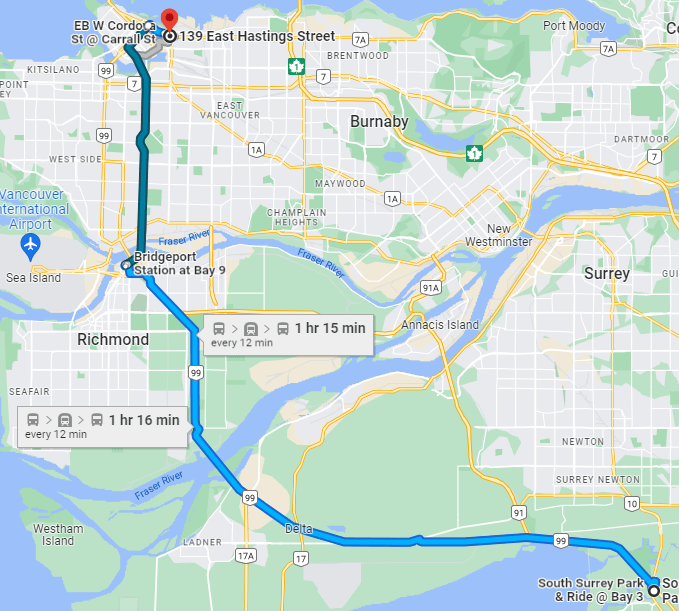
An example of that is my old jaunt to the DTES. I had to drive to the Park & Ride, to get on a bus to Bridgeport Station in Burnaby, to get on the subway to Waterfront Station in Vancouver. The subway usually started out packed to the brim at Bridgeport Station, since it originated at YVR Airport and had a few stops before us. At the next few stops after Bridgeport Station there would usually be crowds of people waiting in lines to get on, with only a few making it per train. However, as we kept hitting stops these lines dwindled to nothing, since more people started getting off than on. The subway car always ended up about one quarter full by Waterfront Station.
When going home this process wasn’t so bad from my perspective, since Waterfront Station was never full and I could always get right on. The subway would fill up again, often to full, before shedding huge quantities of riders at Bridgeport Station. I don’t know what the final numbers looked like when it got to YVR.
The bus I got on went straight from Bridgeport Station to the Park & Ride, so there was no atrophy in ridership there since there was no stop to get off. If there had been a bus that went straight from downtown Vancouver to my house with many stops it would undoubtedly be carrying no one other than me by the time it got there, while being completely over capacity in downtown Vancouver.
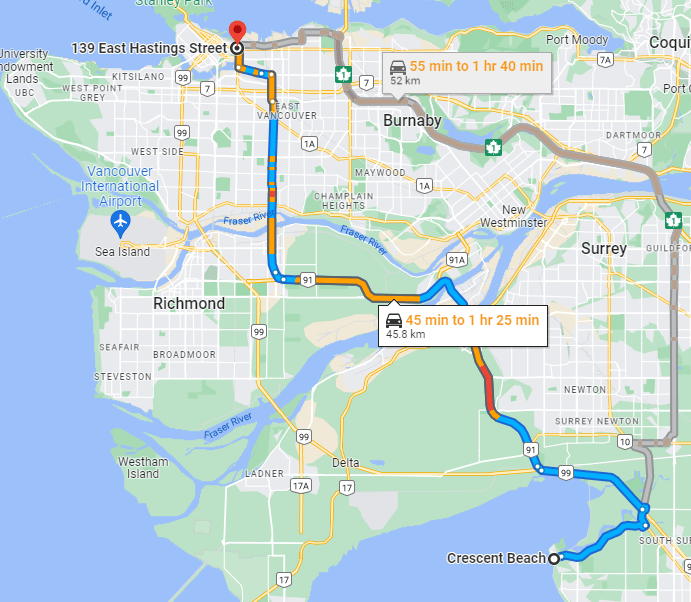
In contrast, driving took half the time and was far more pleasant. With a car you don’t need to worry about getting to a Park & Ride so you can take a bus to get off and take another bus to take a subway, to take a bus to walk to your final destination. You just go from your home to your destination.
Public transit planners, even if they were operating in a ZOG free world and were hard working geniuses, would still face serious problems inherent to non-personalized transportation. The more stops you have on a certain line, the more you are going to have your ridership atrophying at the end, low at the beginning, and potentially overfull in the middle. And if you have any care towards the taxpayer you can’t just throw more buses/railcars at the problem. In some cases, even if you don’t care about cost you can’t just throw more buses/rail at the problem. Remember Just One More Train Bro?
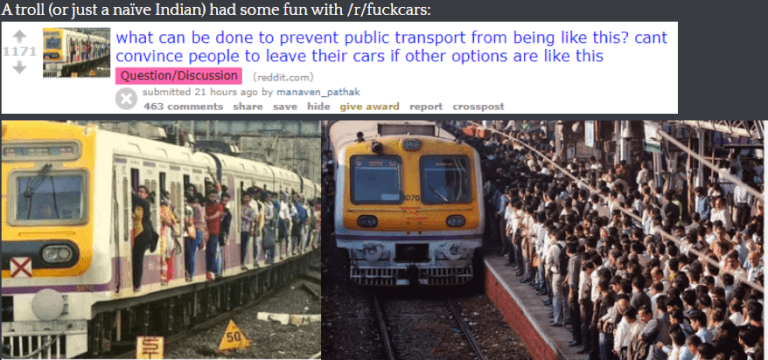
This problem gives planners a strong incentive to congregate people into certain areas in a hub and spoke model, and then go on longer trips with only major stops. But that means people need to start taking multiple transfers between bus and subway lines, which is slow, annoying, and indirect. Or they could get in their car in their garage, and drive directly to their destination.

Everyone who drives has exactly the right transportation they need with them the entire time. Then it sits there doing nothing until they need it to start moving again. This is then reframed by antifa bugcreatures as bad, because the car sits there until it is needed. You know, just like your bed, or a toilet. But it’s bad when cars do it.

Anyway, that was a long tangent. Back to the original article.
Still, with average bus loads falling from 15.1 in 1979 to under 10 in much of the 1990s, recovering to 11.1 in 2013, it is clear that agencies could do better than they do at filling buses. The reason why average bus loads grew from 10.7 in 2012 to 11.1 in 2013 is that transit agencies reduced total bus service by 8 percent, but suffered a mere 4 percent loss in passenger miles as a result. This suggests that transit agencies are running way too many buses and should cut back rather than extend hours.

Why would agencies buy such big buses when they are empty most of the time?
The alternative is to buy smaller buses. But with the federal government being willing to fund 80 percent of the cost of new buses, transit agencies reason they might as well get the biggest they need. After all, they need to hire a driver no matter what the size of the bus, so they might as well get a big one. This erroneously assumes that the cost of operating the bus is limited to the driver’s pay.
Transit agencies may use their share of funds to pay for up to 80 percent of the cost of buses. However, they can use the funds to cover up to 90 percent of the cost if the buses help meet clean air requirements. This explains why transit agencies are so willing to pay twice as much for a hybrid, natural gas, or other “clean” bus as for a regular bus: the amount they pay out of local funds is the same. Yet they wouldn’t do that if they really needed a lot of new buses, which suggests in turn that they have already saturated service with the number of buses they have.
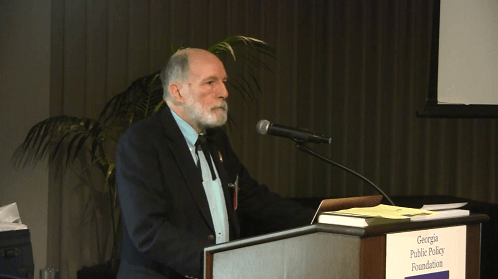
Randall O’Toole
Randall O’Toole is the libertarian behind Antiplanner, and I’m not betting my reputation on him without verification of his claims. In this case, his claim that 80% of bus purchase costs are subsidized by the federal government appears to be very credible.
Federal Transit Administration (Grants for Buses and Bus Facilities Program):
The federal share of eligible capital costs is 80 percent of the net capital project cost, unless the grant recipient requests a lower percentage. The Federal share may exceed 80 percent for certain projects related to the ADA and the Clean Air Act. All low-no emission projects are attributable to compliance with the Clean Air Act and/or the Americans with Disabilities Act. Therefore, the Federal share of the cost of leasing or purchasing a low or no emission transit bus is not to exceed 85 percent of the total transit bus cost. The federal share in the cost of leasing or acquiring low- or no-emission bus-related equipment and facilities is 90 percent of the net project cost. Applicants must identify these specific activities in their application in order to receive this increased federal share.
Not just buses, the whole shebang gets 80% subsidized by the federal government. Buses, equipment, facilities. You name it. 90% if it’s electric.
Is this song related? Not really. It’s just nice.
The Atlanta Journal Constitution:
Cobb County’s public transit system will replace 12 of its aging buses with the help of a federal grant.
Commissioners recently approved the $8.3 million purchase of the buses, which will be added to the county’s CobbLinc fleet. The Federal Transit Administration (FTA) funds will pay 80% of the cost, nearly $6.7 million, for the 40-foot buses. Cobb County will pay the remaining $1.6 million.
And in about ten seconds of searching I found a random article from Atlanta explaining that the FTA will pay 80% of the cost for new 40 foot buses. So if you’re wondering why you see enormous empty buses everywhere, it’s probably because your taxes subsidize the purchase cost of these things for the people who are buying them, transit bureaucracies.

Let’s do a bit of math, shall we? If this site is correct, and the average life expectancy for a bus in the US is 12 years, and this site is correct, and the average salary for a bus driver is just $42k/year, call it $50k, and if this site is correct and the average maintenance cost for a schoolbus is $5.5k/year, which is closer to our smaller bus size, then we are spending about $55k/year on driver and maintenance salaries per bus, with administrative costs being assumed as fixed. Therefore, each bus costs us $660k in driver and maintenance costs in its lifetime.
NOTE: The above analysis is quick and dirty, and assumes, among other things, that we need one driver per bus. We may require more, or less, depending on how used each bus is. But it also ignores the increased energy and maintenance costs of larger vehicles.
In contrast, the purchase cost for those Atlanta buses works out to $691k. That it is so heavily subsidized is what leads to the erroneous myth that purchase costs are irrelevant, therefore you should buy the biggest bus possible so as to minimize the drivers you need to fund.

If you’re thinking that I’m combatting a strawman, here you go, straight from the mouth of Big Soy.
Transit operating cost is mostly labor. The cost of a bus is in the driver, not the size of the vehicle. So it doesn’t cost much for the vehicle to be bigger than needed.

Human Transit is yet another Urbanite Blog where they repeat the same dumb talking points as all the other Traffic NPC’s. The man behind it is Jarrett Walker. He looks like this.

Jaime can we zoom in on that.

Thanks, Jaime.
When people want to imply that public transit is irrelevant or failing or wasteful, they always point to relatively empty buses or trains. To the layman it certainly seems as though buses with few passengers aren’t achieving much.

But you see, intelligent people understand that buses being completely empty is a very intelligent way to spend taxpayer dollars.
This common line is based on two false assumptions. It assumes that empty seats indicates waste, which they usually don’t, and it falsely assumes that ridership is transit’s only measure of success, which it isn’t.
In fact, when a transit agency runs a relatively empty bus, they’re doing what they’re told to do, and they’re doing it efficiently.
But it costs a lot for the bus to be too small. Then you have crowding, or you leave passengers behind.
Demand for transit goes up and down during the day, and on different parts of the route. It also goes up and down for unpredictable reasons. A school decides to have a field trip, and a normally empty bus is suddenly packed. Nice or bad weather can change ridership patterns suddenly.
Funny, because the exact same argument about theoretical max capacity works in favour of buying the biggest minivan or SUV you can afford. And yet these same fags support slashing the tires of SUV’s.
A group claiming to be environmental activists is taking responsibility after the tires of dozens of SUVs were flattened overnight in Kitchener, Ont.
Waterloo regional police say they’ve received more than 30 reports of property damage to SUVs parked in driveways in the Glasgow Heights and Stanley Park areas of Kitchener.
Police say the suspects left notes on windshields stating: “Your gas guzzler kills.”

For the record the argument he’s making is dumb anyway. If you have sudden, unpredictable bursts of bus demand, but low average demand, it makes far more sense to have a greater number of smaller buses on the road, even at the expense of reduced theoretical capacity. That way everyone enjoys faster service all the time, and when you have a little burst you just have multiple buses take them all. Sure, it might be slightly longer for those people, but it’s better for everyone else to have regular bus service.
Buses and trains cannot dynamically shrink or expand to match these changing demands, and since the operating cost lies mostly in the driver, there wouldn’t be much to gain by doing that.
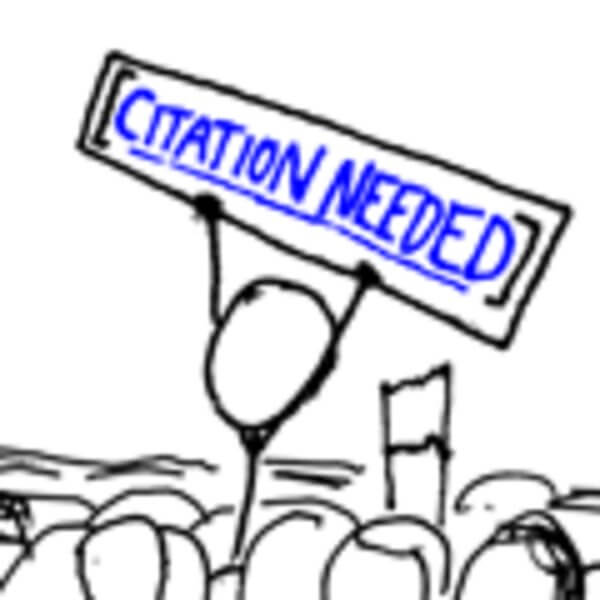
So transit agencies are smart to run the biggest bus they will ever need, even though that means the bus will be empty at some hours, or on some parts of the route, or even on some days when demand is lower. They may even run a bigger bus than a route ever needs, because there are also massive inefficiencies in having too many different kinds of buses. Smart agencies have thought this through and what they are doing, in my experience, mostly makes sense.
Get a load of how smart we are to run empty buses everywhere because we might need that capacity one day.

Also, that guy has multiple sentences where he adds an extra space for no reason, including the one where he says “Smart agencies…”. Ironic.
This is such a great example of snarky midwitism. He constantly refers to doing something stupid, running buses at way under max capacity, as intelligent, while throwing some strawmen out there about theoretical max demand. The problem is, theoretical max demand is infinite, which xir uses to justify buying infinitely large buses, or at least the biggest they can fit on the road.
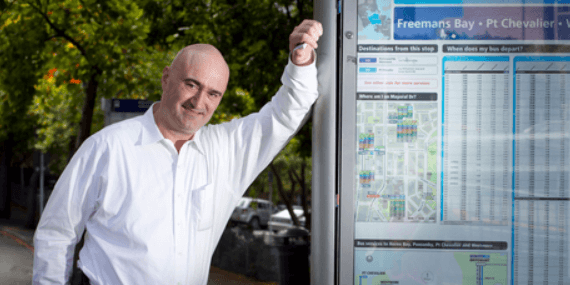
Jarrett Walker
Here’s his argument. Imagine we have a concert finishes in a downtown area. At the same time a major sporting event finishes. Simultaneously, a film festival shuts down due to a technical reason. The sun was bright and shining, so people went to the beach, but then it started to rain so now they all want to go home. Also, there’s just randomly a spike in bus demand due to what is essentially random noise in terms of a thousand different personal reasons why people decided to shop or whatever right now.
We have a once in a thousand days super spike in bus demand. And according to Jarrett Walker, we absolutely must have enough buses already running that none of those people have to wait for the next one. Or if, God forbid, they have to wait one bus, then they should definitely get on the next one, and it should already be at the station.

So you see, it’s not just reasonable, but the SmARt PerSoN ThINg to clog up the roads day after day with gigantic bus after gigantic bus, even if their average ridership is just one tenth what their max capacity is, because we absolutely must not ever force anyone to wait 30 minutes at the station while some demand spike gets worked through. That’s just unconscionable, because reasons.
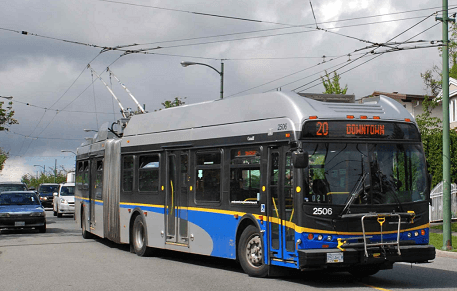
Of course, if you need huge buses then you need them.
I am really tired of this bullshit masquerading as intelligent analysis. It is perfectly fine for a once in a thousand days confluence of events to massively oversaturate one particular bus line, causing a two hour long wait for passengers while the crowd gets worked through. Having slightly higher peak demand than capacity just means that people wait a little longer before getting their ride. It also means that you spend massively less on capital costs, as well as somewhat less on energy and maintenance. But of course the government pays 80% of the initial capital costs, so we all have to deal with the empty chonkers on the road instead of these guys.
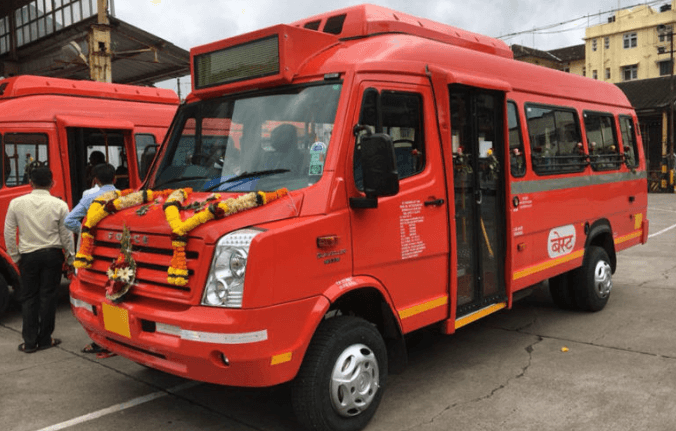
Yes, it is most cost efficient in terms of capacity to have fewer enormous buses than more smaller buses, but if the capacity is wasted than the capacity is irrelevant. If you have twice as many buses with one quarter the capacity, you get twice the frequency, twice the coverage, or some combination of the two, which is what people care about except when the bus is completely full. This is obvious, but to the “induced demand,” types it’s crazy thinking. After all, if we rationally plan our bus lines for the actual demand than we can’t shove everyone into the cuckbox.
NOTE: Of course, what people care most about is crime, and these antifas all support pro-crime policies.
The 2020 Covid-19 epidemic proved this point. Instead of shutting down and laying off most staff, as a profit-making business would logically do, most big city agencies did their best to run service, not just to keep their staff employed but also to enable those “essential service” workers to get around, so that the city could keep functioning. To do this, and to encourage social distance, they ran intentionally “empty” buses and discouraged people from riding them. In this, transit revealed itself to be the opposite of a business. It’s a utility, an essential element of the functioning of a city.

Have you never heard of a fucking taxi?! Do you not understand that an empty bus provides no utility to anyone, and a bus with one passenger would better serve them by just driving them straight to their destination? I feel like I’m taking crazy pills when I read these urbanites make obnoxiously stupid arguments for public transit that prove the opposite of what they think they do, to the point where “we can run public transit with no one on it, therefore it is good,” becomes a legitimate argument in their toolbag.

It’s also interesting how we have this freakish combination of free markets and central planning in this country, that always works out against the interest of the people. They can’t just pay their employees to sit at home and do nothing like they could in a total command economy. But they also have to give essential workers transportation.
So they get their public transit workers to waste ungodly amounts of their time and huge amounts of energy running trains and buses that are empty, just in case an essential worker might need a lift. But they don’t just offer essential workers free taxi rides, because they’re stupid, corrupt, uncaring, and no individual bureaucrat has the authorization to do that.
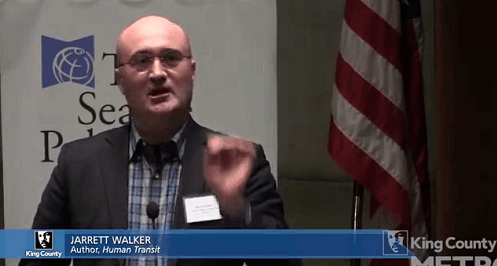
Then whatever the hell this is praises them for it.













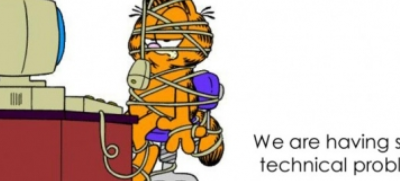

Living in China I saw all sort of buses being used and used to capacity, buses are pretty good in high density Chinese cities. They have implemented bus lanes during rush hour, which is kinda gay, but makes the buses much faster.
But they don’t use those big chonking huge buses in the city, and then out in the less dense areas they have fewer bus lines, smaller buses, and run less frequently… it’s a weird concept, I know.
Of course the “less dense” areas are less dense by Chinese standard, so we’re probably still looking at five to ten times the density of a city like Tulsa.
Even with those sensible ways of running buses, I am quite confident that they’re run at a loss. Thing is that they probably are a decent investment by the government, and even when it’s not a good investment at least it’s good old fashioned graft and corruption at work.
side note: what do you call a chinese man who has been raised on soy and eating soy his whole life? I mean when you eat tofu, and drink soy milk every day then calling you a soyboy seems… erm..
I enjoy reading your counterpoints to the “green” narrative. I always knew something was a little off with public transit, and I didn’t realize how intractable some of the problems were. Add into the mix the fact that the term “public” includes free-riders such as the mentally ill, the homeless, drug-users, dindus, diversity, and other assorted riff raff, then buses are just basically misery on wheels. Avoid, avoid, avoid!!
“So next time you see a bus that’s empty, please don’t assume that no one rides.”
I was going to note that this perfectly encapsulates the sort of advice/argument you always get from Left/Libertarians; whether arguing for socialism or muh free market, it’s always boils down to a direct slap in the face of common sense. Chutzpah, if you will. You’ll also note that this mirrors Finklethink: the Left always gets what it wants, the Right no so much. The Left’s affronts to common sense get framed as “science” or “inevitable” while the Right’s affront are left to die from being laughed out of court.
But then we go this other verbal tic: “It might seem to the layman…” Ah yes, as with COVID, so with transit, it’s “settle science”, “scientific consensus”, “studies say” etc. so STFU. It even works for they themselves: “What is a woman? I don’t know, I’m not a biologist. Sit me on the Supreme Court, goyim.”
This discussion of busses vs. taxis in COVID time reminds me of what has occurred to me when riding the bus: the decision to retrofit or redesign busses with elaborate mechanical ramps for the handicapped, resulting in seemingly long delays for entrance and exit. Now, this isn’t about “to Hell with cripples” it’s a question of the best solution. Wouldn’t it be better to offer free/subsidized taxis rather than dumping the whole thing on the main bus system? It’s like the previous mandate to add ramps everywhere, just in case a handicapped person might someday try to enter.
As always, the “answer” is massive govt. spending and upending the whole society (“progress”, improvement, either “inevitable evolution” or “scientific methods”), rather than just dealing with it on the micro level, (Eg., don’t tolerate the “gender noncomforming” but retrofit bathrooms, devise new pronouns, create a new agency to enforce all this, etc.)
It always reminds me of a story Alan Watts used to tell, about a Near Eastern potentate who had the idea to improve his subjects’ lives by killing thousands of cows and using the leather to pave all the roads. An advisor approached and said in his ear, “O King, live forever! But would it not be easier to give everyone shoes?” Well, of course not; where’s the glory or GDP in that?
Great comment. However, if you define pro-war and pro-corporate as being “right wing,” then all of a sudden the roles are reversed, and (((David Frum))) explaining how the humanitarian choice is ACKSHUALLY to commit mass murder against the enemies of Israel gets taken seriously.
And Ayn Rand is pro-white because she says “Indians don’t have a right to the land just cuz they were born on it”, conveniently carving out a great big gaping hole for isreal, while not really addressing the issue of injuns in America.
The most important thing I learnt studying engineering is that engineering is a game of compromise, especially as the scale of the project increases. For something as vast as public transport, any solution is going to have drawbacks.
For example, I’m of the opinion that fleets of self driving cars are probably the best solution to public transport. It sidesteps the partial trip problem entirely by being able to transport you from where you are to where you need to be.
But there are drawbacks. There will be a delay between requesting a car and it arriving to pick you up, which you don’t have with private car ownership. And figuring out the sweet spot between managing traffic congestion and wait times will be tricky (but not impossible with good data gathering and analysis).
There’s also a very real concern of privacy – any such fleet operator could theoretically collect detailed histories of people’s riding habits to use for any number of nefarious purposes.
There’s also issues surrounding hygiene – I wouldn’t want to ride in a car that had just been used to transport around a bunch of drunk club goers or worse, drug addicts and homosexuals.
Lastly there’s also the fact that widespread adoption requires people to overcome the very understandable trepidation that comes with trusting their lives to an AI that was in all likelihood coded by some soy huffing troon under the close supervision of a Berg or a Stein, or worse still, a Pajeet whose understanding of programming languages is worse than their understanding of English.
These Antifa types would be upset that your private toilet doesn’t have someone using it 100% of the time, as well as your bed.